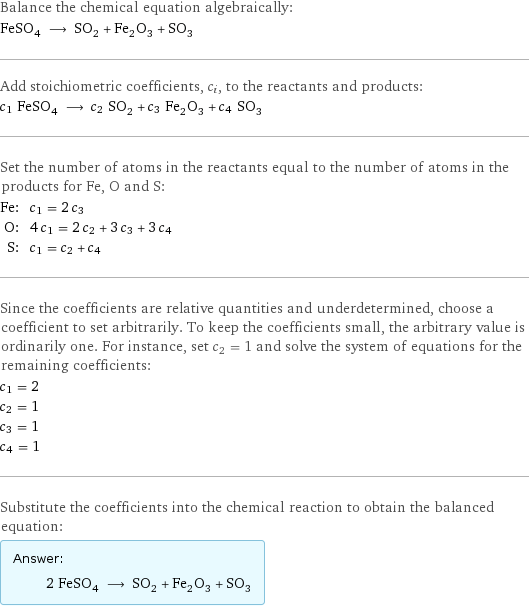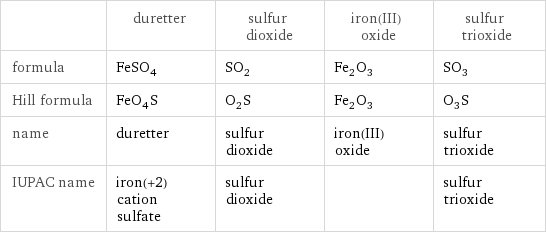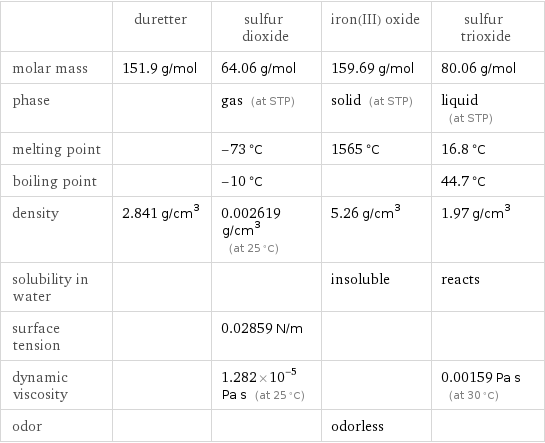Input interpretation

FeSO_4 duretter ⟶ SO_2 sulfur dioxide + Fe_2O_3 iron(III) oxide + SO_3 sulfur trioxide
Balanced equation

Balance the chemical equation algebraically: FeSO_4 ⟶ SO_2 + Fe_2O_3 + SO_3 Add stoichiometric coefficients, c_i, to the reactants and products: c_1 FeSO_4 ⟶ c_2 SO_2 + c_3 Fe_2O_3 + c_4 SO_3 Set the number of atoms in the reactants equal to the number of atoms in the products for Fe, O and S: Fe: | c_1 = 2 c_3 O: | 4 c_1 = 2 c_2 + 3 c_3 + 3 c_4 S: | c_1 = c_2 + c_4 Since the coefficients are relative quantities and underdetermined, choose a coefficient to set arbitrarily. To keep the coefficients small, the arbitrary value is ordinarily one. For instance, set c_2 = 1 and solve the system of equations for the remaining coefficients: c_1 = 2 c_2 = 1 c_3 = 1 c_4 = 1 Substitute the coefficients into the chemical reaction to obtain the balanced equation: Answer: | | 2 FeSO_4 ⟶ SO_2 + Fe_2O_3 + SO_3
Structures

⟶ + +
Names

duretter ⟶ sulfur dioxide + iron(III) oxide + sulfur trioxide
Equilibrium constant
![Construct the equilibrium constant, K, expression for: FeSO_4 ⟶ SO_2 + Fe_2O_3 + SO_3 Plan: • Balance the chemical equation. • Determine the stoichiometric numbers. • Assemble the activity expression for each chemical species. • Use the activity expressions to build the equilibrium constant expression. Write the balanced chemical equation: 2 FeSO_4 ⟶ SO_2 + Fe_2O_3 + SO_3 Assign stoichiometric numbers, ν_i, using the stoichiometric coefficients, c_i, from the balanced chemical equation in the following manner: ν_i = -c_i for reactants and ν_i = c_i for products: chemical species | c_i | ν_i FeSO_4 | 2 | -2 SO_2 | 1 | 1 Fe_2O_3 | 1 | 1 SO_3 | 1 | 1 Assemble the activity expressions accounting for the state of matter and ν_i: chemical species | c_i | ν_i | activity expression FeSO_4 | 2 | -2 | ([FeSO4])^(-2) SO_2 | 1 | 1 | [SO2] Fe_2O_3 | 1 | 1 | [Fe2O3] SO_3 | 1 | 1 | [SO3] The equilibrium constant symbol in the concentration basis is: K_c Mulitply the activity expressions to arrive at the K_c expression: Answer: | | K_c = ([FeSO4])^(-2) [SO2] [Fe2O3] [SO3] = ([SO2] [Fe2O3] [SO3])/([FeSO4])^2](../image_source/2e80d2e706a5f89872eaf1fad3ca562b.png)
Construct the equilibrium constant, K, expression for: FeSO_4 ⟶ SO_2 + Fe_2O_3 + SO_3 Plan: • Balance the chemical equation. • Determine the stoichiometric numbers. • Assemble the activity expression for each chemical species. • Use the activity expressions to build the equilibrium constant expression. Write the balanced chemical equation: 2 FeSO_4 ⟶ SO_2 + Fe_2O_3 + SO_3 Assign stoichiometric numbers, ν_i, using the stoichiometric coefficients, c_i, from the balanced chemical equation in the following manner: ν_i = -c_i for reactants and ν_i = c_i for products: chemical species | c_i | ν_i FeSO_4 | 2 | -2 SO_2 | 1 | 1 Fe_2O_3 | 1 | 1 SO_3 | 1 | 1 Assemble the activity expressions accounting for the state of matter and ν_i: chemical species | c_i | ν_i | activity expression FeSO_4 | 2 | -2 | ([FeSO4])^(-2) SO_2 | 1 | 1 | [SO2] Fe_2O_3 | 1 | 1 | [Fe2O3] SO_3 | 1 | 1 | [SO3] The equilibrium constant symbol in the concentration basis is: K_c Mulitply the activity expressions to arrive at the K_c expression: Answer: | | K_c = ([FeSO4])^(-2) [SO2] [Fe2O3] [SO3] = ([SO2] [Fe2O3] [SO3])/([FeSO4])^2
Rate of reaction
![Construct the rate of reaction expression for: FeSO_4 ⟶ SO_2 + Fe_2O_3 + SO_3 Plan: • Balance the chemical equation. • Determine the stoichiometric numbers. • Assemble the rate term for each chemical species. • Write the rate of reaction expression. Write the balanced chemical equation: 2 FeSO_4 ⟶ SO_2 + Fe_2O_3 + SO_3 Assign stoichiometric numbers, ν_i, using the stoichiometric coefficients, c_i, from the balanced chemical equation in the following manner: ν_i = -c_i for reactants and ν_i = c_i for products: chemical species | c_i | ν_i FeSO_4 | 2 | -2 SO_2 | 1 | 1 Fe_2O_3 | 1 | 1 SO_3 | 1 | 1 The rate term for each chemical species, B_i, is 1/ν_i(Δ[B_i])/(Δt) where [B_i] is the amount concentration and t is time: chemical species | c_i | ν_i | rate term FeSO_4 | 2 | -2 | -1/2 (Δ[FeSO4])/(Δt) SO_2 | 1 | 1 | (Δ[SO2])/(Δt) Fe_2O_3 | 1 | 1 | (Δ[Fe2O3])/(Δt) SO_3 | 1 | 1 | (Δ[SO3])/(Δt) (for infinitesimal rate of change, replace Δ with d) Set the rate terms equal to each other to arrive at the rate expression: Answer: | | rate = -1/2 (Δ[FeSO4])/(Δt) = (Δ[SO2])/(Δt) = (Δ[Fe2O3])/(Δt) = (Δ[SO3])/(Δt) (assuming constant volume and no accumulation of intermediates or side products)](../image_source/d9785d9b197e3b210625a1200d3cd879.png)
Construct the rate of reaction expression for: FeSO_4 ⟶ SO_2 + Fe_2O_3 + SO_3 Plan: • Balance the chemical equation. • Determine the stoichiometric numbers. • Assemble the rate term for each chemical species. • Write the rate of reaction expression. Write the balanced chemical equation: 2 FeSO_4 ⟶ SO_2 + Fe_2O_3 + SO_3 Assign stoichiometric numbers, ν_i, using the stoichiometric coefficients, c_i, from the balanced chemical equation in the following manner: ν_i = -c_i for reactants and ν_i = c_i for products: chemical species | c_i | ν_i FeSO_4 | 2 | -2 SO_2 | 1 | 1 Fe_2O_3 | 1 | 1 SO_3 | 1 | 1 The rate term for each chemical species, B_i, is 1/ν_i(Δ[B_i])/(Δt) where [B_i] is the amount concentration and t is time: chemical species | c_i | ν_i | rate term FeSO_4 | 2 | -2 | -1/2 (Δ[FeSO4])/(Δt) SO_2 | 1 | 1 | (Δ[SO2])/(Δt) Fe_2O_3 | 1 | 1 | (Δ[Fe2O3])/(Δt) SO_3 | 1 | 1 | (Δ[SO3])/(Δt) (for infinitesimal rate of change, replace Δ with d) Set the rate terms equal to each other to arrive at the rate expression: Answer: | | rate = -1/2 (Δ[FeSO4])/(Δt) = (Δ[SO2])/(Δt) = (Δ[Fe2O3])/(Δt) = (Δ[SO3])/(Δt) (assuming constant volume and no accumulation of intermediates or side products)
Chemical names and formulas

| duretter | sulfur dioxide | iron(III) oxide | sulfur trioxide formula | FeSO_4 | SO_2 | Fe_2O_3 | SO_3 Hill formula | FeO_4S | O_2S | Fe_2O_3 | O_3S name | duretter | sulfur dioxide | iron(III) oxide | sulfur trioxide IUPAC name | iron(+2) cation sulfate | sulfur dioxide | | sulfur trioxide
Substance properties

| duretter | sulfur dioxide | iron(III) oxide | sulfur trioxide molar mass | 151.9 g/mol | 64.06 g/mol | 159.69 g/mol | 80.06 g/mol phase | | gas (at STP) | solid (at STP) | liquid (at STP) melting point | | -73 °C | 1565 °C | 16.8 °C boiling point | | -10 °C | | 44.7 °C density | 2.841 g/cm^3 | 0.002619 g/cm^3 (at 25 °C) | 5.26 g/cm^3 | 1.97 g/cm^3 solubility in water | | | insoluble | reacts surface tension | | 0.02859 N/m | | dynamic viscosity | | 1.282×10^-5 Pa s (at 25 °C) | | 0.00159 Pa s (at 30 °C) odor | | | odorless |
Units
